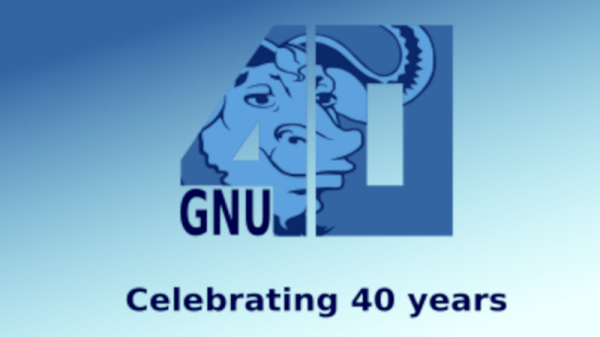Tomorrow, 27th September, marks the fortieth anniversary of the founding of the GNU Project, without which there would be no free software (which some also call open source. Ed.) and no GNU/Linux operating system, which is quite often abbreviated to just Linux.

Four decades ago, technology began to shape our lives: it was the early 1980s, computers did not yet fit into our pockets but filled large rooms, as they had done in the mid-1970s, when your ‘umble scribe took a module called Computer Appreciation as part of his polytechnic modern languages degree (no Molière and Goethe for us! Ed.). In 1982, the Time magazine named the computer as its “Person of the Year“. About this time, point, some people had already started pointing out the need to give users control over this technology. So in 1983 the GNU Project was announced by Richard Stallman. The project’s aim was to create an operating system consisting entirely of free software to allow people to use, understand, adapt and share software. Two years later the Free Software Foundation was established as the legal backbone for the GNU project.
Today the free software movement is a broad global movement encompassing small local companies, worldwide corporations, civil society organisations and thousands of professionals, who are working towards a world where the four freedoms are guaranteed:
- The freedom to run the program as you wish, for any purpose (freedom 0);
- The freedom to study how the program works, and change it so it does your computing as you wish (freedom 1). Access to the source code is a precondition for this;
- The freedom to redistribute copies so you can help your neighbour (freedom 2); and
- The freedom to distribute copies of your modified versions to others (freedom 3). By doing this you can give the whole community a chance to benefit from your changes. Access to the source code is a precondition for this.
These rights go hand in hand with other fundamental rights such as freedom of speech, freedom of the press and privacy.
In 1992, the essential components of the GNU operating system were complete, except for one, the kernel. When the Linux kernel was released under the GNU GPL in 1992, the combination of GNU and Linux formed a complete free operating system – GNU/Linux system as we know it today.
The GPL pioneered the concept of “copyleft” – as opposed to copyright. Stallman envisaged this as a means of preventing GNU from ever becoming proprietary software (like all those expensive Microsoft products. Ed.) This does not exclude free S#software from being sold, as long as the buyers are not restricted from exercising the above-mentioned four rights after purchase. Free Software can also be commercialised in other ways, e.g. by selling support, services or certification.
Today GNU/Linux forms the backbone of the Internet and powers millions of servers and desktops, as well embedded computing devices, whilst software has become an indispensable resource for the modern world
How did the name GNU come about? It’s an acronym for GNU’s not Unix, as the original idea was to create a clone of Unix – a proprietary operating system – but containing no proprietary code. That makes GNU a recursive acronym, i.e. an acronym that refers to itself.
Happy 40th birthday, GNU!